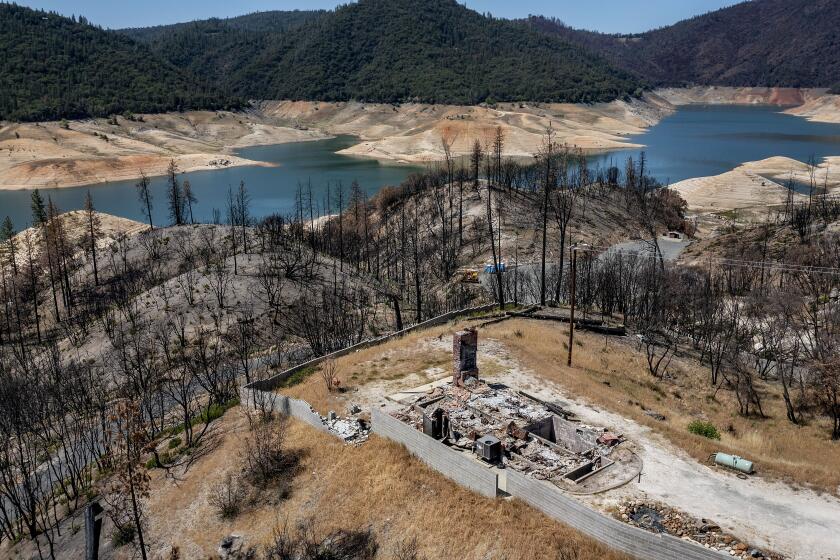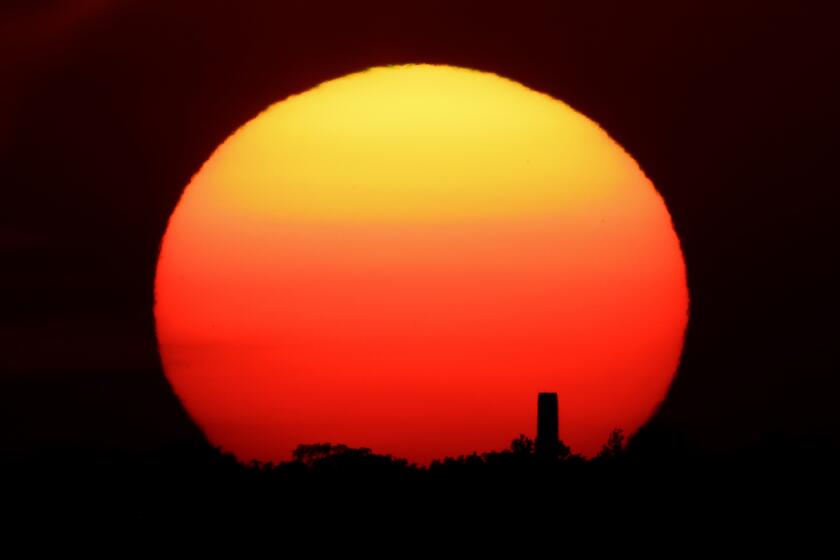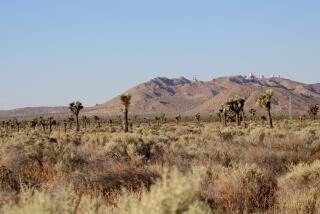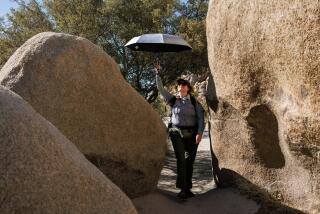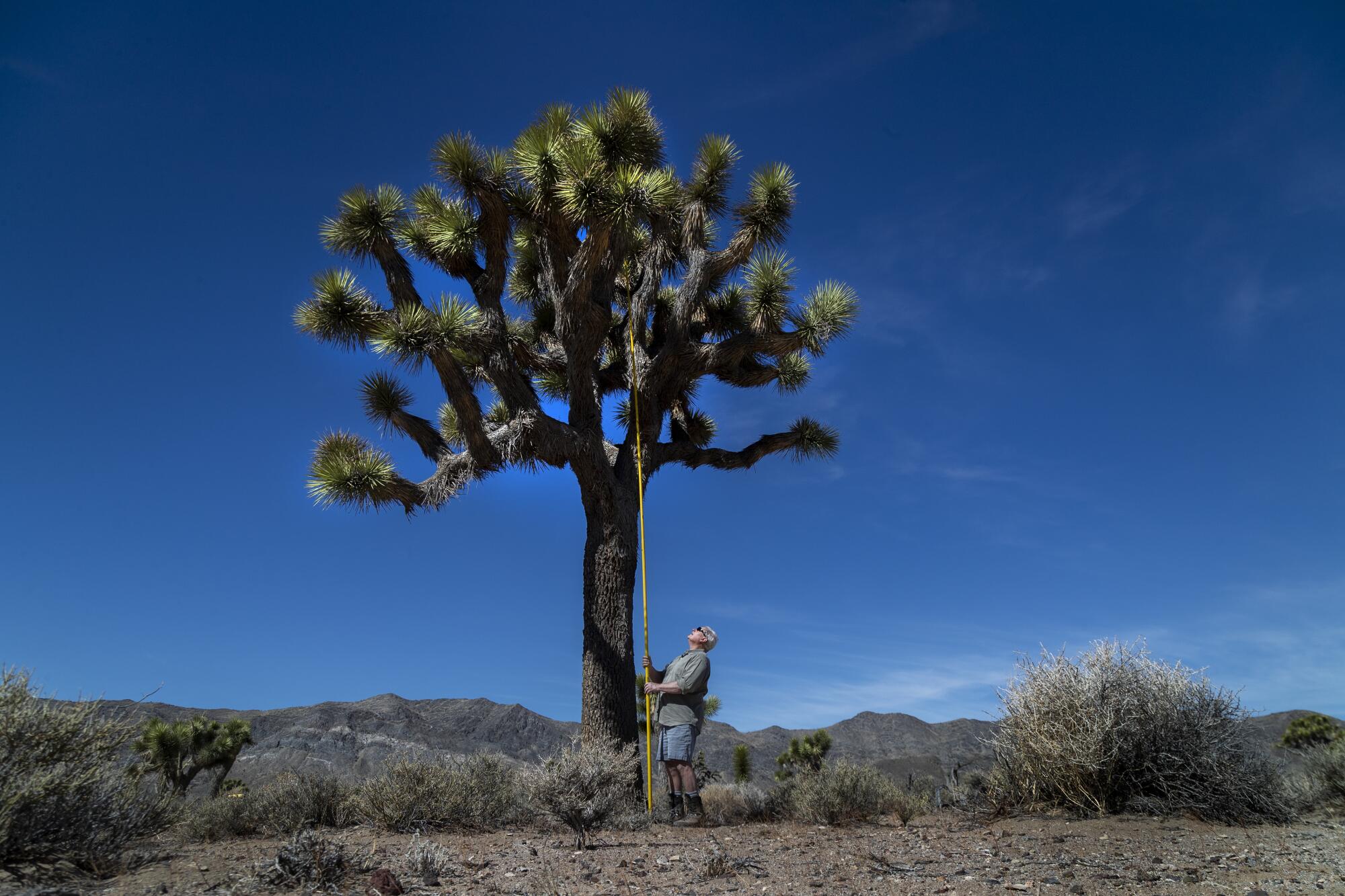
- Share via
If you have any questions about how the plants and animals of Southern California’s deserts are faring as the Earth gets hotter and drier, Jim Cornett is a good bet to have the answers. Roadrunners, palm trees, snakes, Joshua trees — Cornett has studied them all and written more than 40 books.
But the 72-year-old ecologist, who fell in love with the desert as a schoolboy and is still on his honeymoon 60 years later, was stumped one day in April near the southern entrance to Joshua Tree National Park.
It was just past noon when Cornett came upon a rat’s nest built into the base of an ocotillo, a spindly, long-stemmed plant with Kelly-green leaves and lipstick-red flowers that bloom in spring. This ocotillo was brown and dry, thanks to the drought, and it was sporting a nest the size of a small tumbleweed, fashioned from the brittle twigs of creosote bushes and other plants.
“This is only the second time in my life that I’ve seen a wood rat’s nest in a living ocotillo,” said Cornett, who makes multiple visits each year to dozens of study sites to monitor the growth and health of ocotillo plants, Joshua trees and fan palms. “This was not here last year, and I’m shocked to see it.”
Cornett, a husky, white-haired gent with contagious curiosity, bent down and studied the makeshift habitat, wondering aloud whether the occupant was home, either dead or alive. Cornett, who reads the desert as if it were a book, straightened up and scanned the surrounding landscape of dried vegetation, including the crunchy remains of last year’s wildflower bloom.
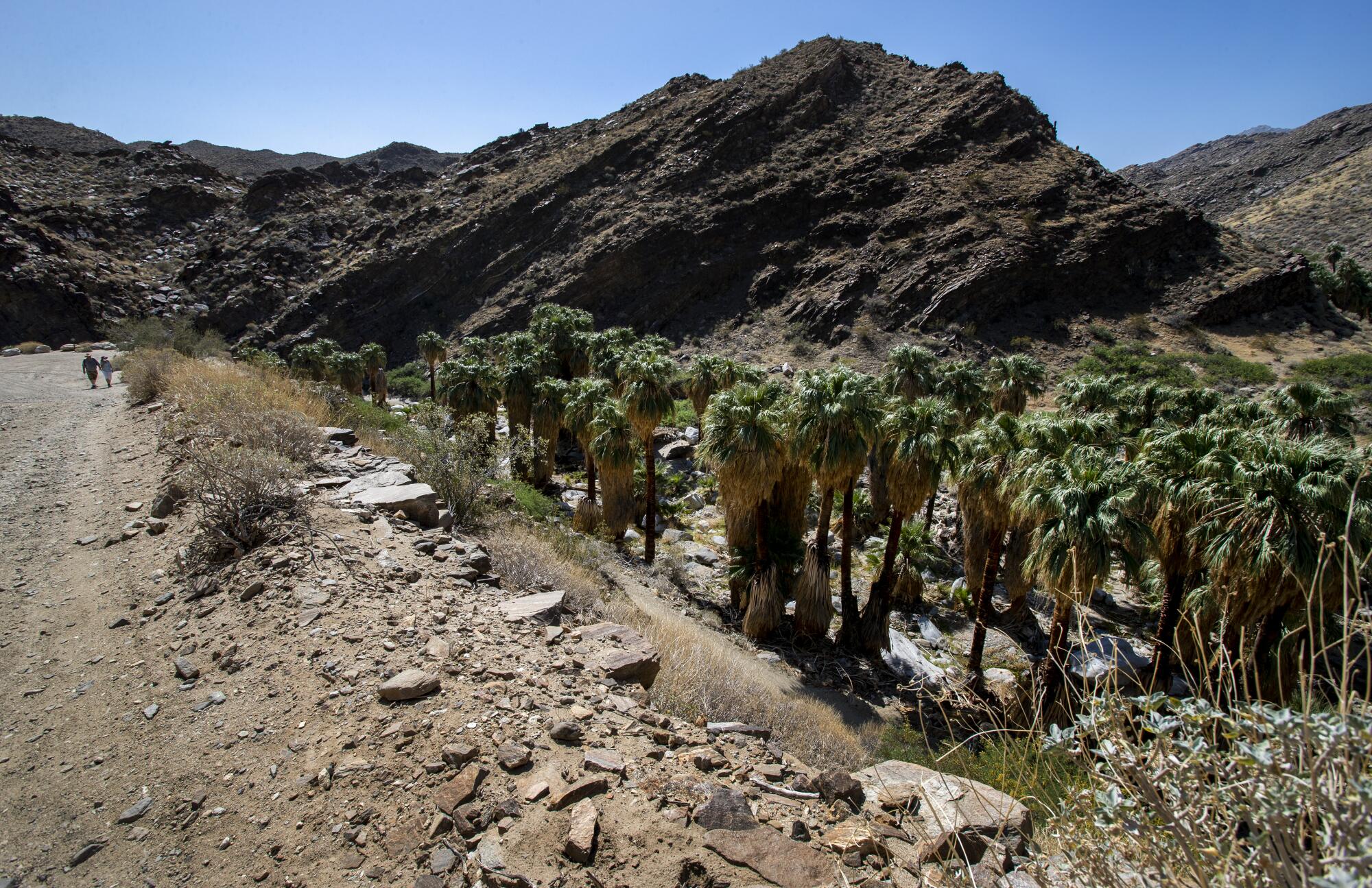
In the distance, I saw what looked like a similar nest. We walked over, and, indeed, another rat appeared to have built a home into the base of an ocotillo.
Cornett began threading a theory.
“Wood rats are 100% dependent on moist food,” he said, “but there are no spring annuals, and no green growth of any kind here. Zero. The cactus are all dead here now because of the changing climate.”
Wood rats used to build nests under the cactuses at this location, Cornett said, because they rely on the shade to survive extreme heat and make do without plentiful rainfall. They tend to avoid ocotillos, he said, because a good breeze jostles the stems and that could bring down a nest. But with so many other plants as dry as death, perhaps ocotillos were the next best option.
Cornett was fascinated by what appeared to be the rodent’s desperate survival strategy, but doubtful that it would help.
“He’s gonna fry this summer,” he said. “This is not going to work.”

::
In late March, my wife and I were headed to the desert for a few days and wondered whether, with scant rainfall, there’d be any spring wildflowers to see. I checked the Desert Sun newspaper and saw a quote from Cornett:
“Let me put it this way,” he said. “This is a disastrous year for wildflowers. I haven’t seen it this bad in memory.”
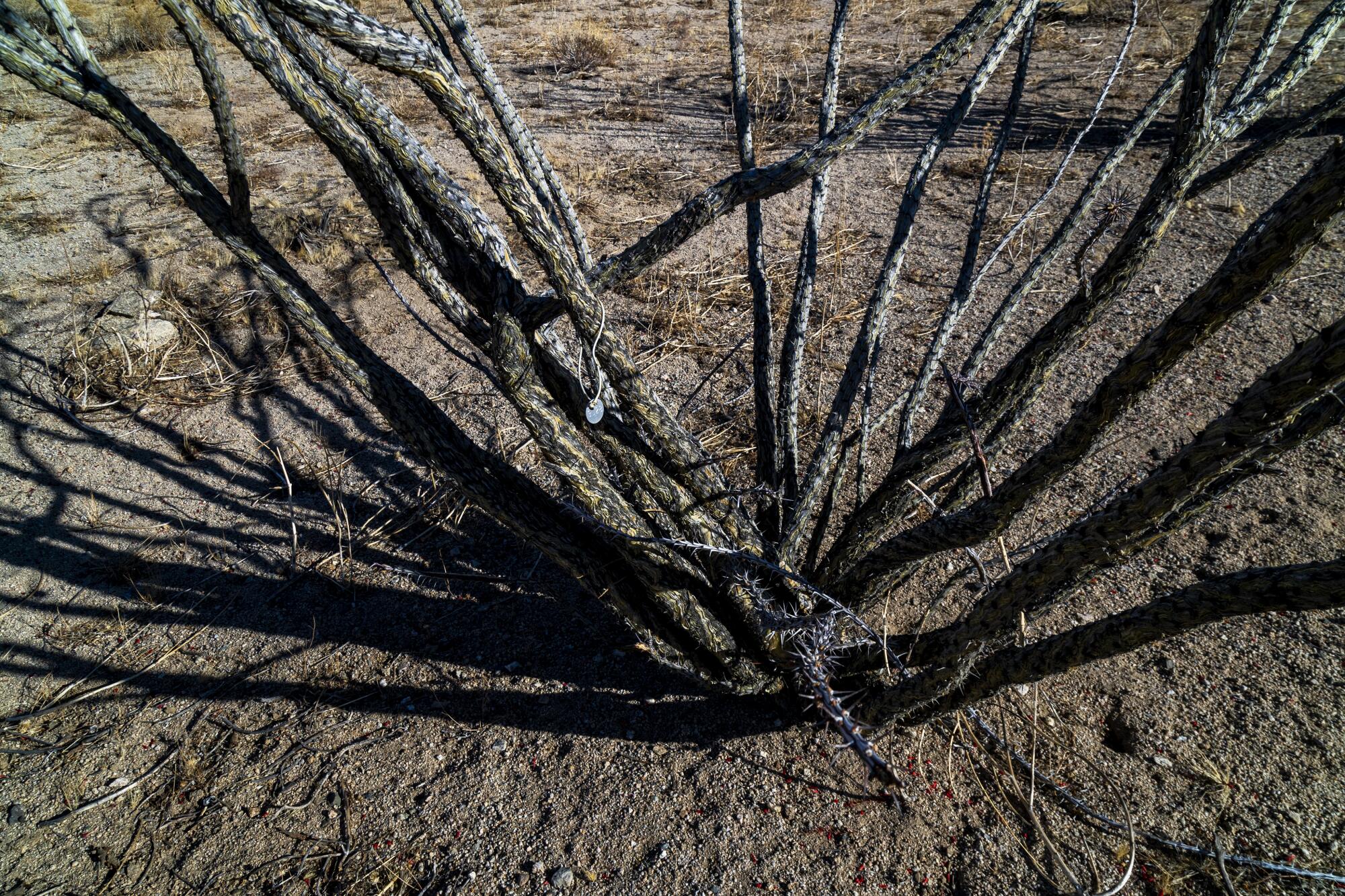
He was right. On a five-mile hike near Lake Cahuilla in La Quinta, my wife and I saw bighorn sheep, but no wildflowers.
In the last year, I’ve written about the ways in which extreme heat, drought and diminishing fog have affected California’s wine industry, redwood trees and marine habitats. I was curious about whether there were visible changes in the desert, so I called Cornett. And that’s how I ended up staring at rat nests in ocotillos.
“Our desert areas in California are being rather dramatically changed in composition and appearance,” Cornett said, offering an assessment that casual visitors may have trouble grasping. The desert was dry before. It’s still dry. So what is changing, and why should we care?
How about this: Joshua Tree National Park might one day not be the best place to see Joshua trees. Some will survive, Cornett predicts, but many will die.
Cornett, in fact, is documenting this and other desert ecosystem transformations for a book, which has a working title of “The California Deserts: Then and Now.” The book will feature a collection of photographs Cornett has taken over time, demonstrating the decline of plant life by aiming his lens at the same locations over a decades-long span.
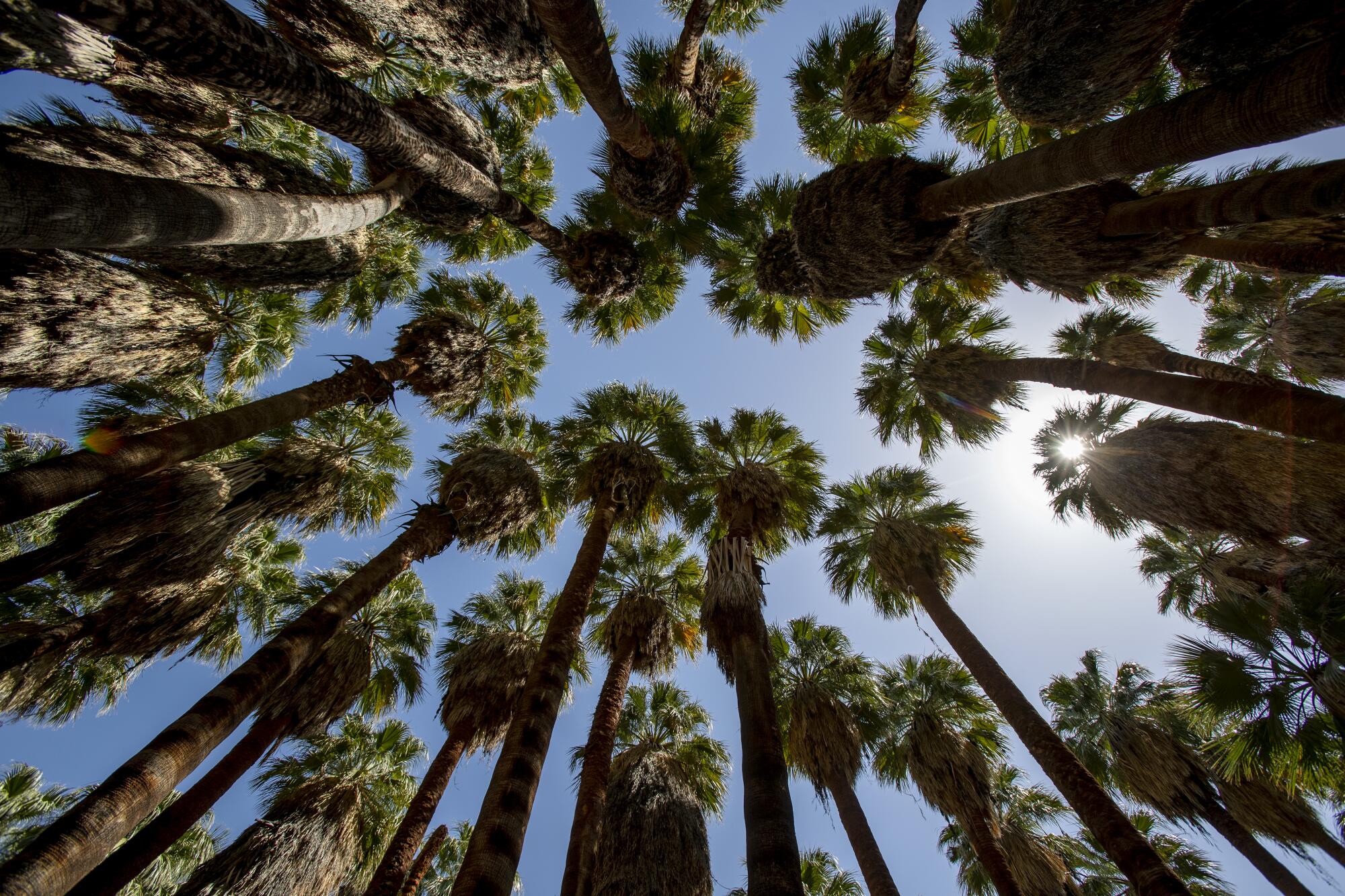
The rat nests in the ocotillos are part of a much bigger saga, he said, in which the characters are insects, birds, rodents, lizards, snakes and other wildlife, along with plant species. Climate- related change has a cascading effect, Cornett said, using the ocotillo to illustrate his point.
“The ocotillo is a critically important nectar-producing plant that is vital for migrating hummingbirds that come up from Mexico,” Cornett said. “There may be some species of hummingbirds that will either cease migrating or become extinct because of the slow demise of the ocotillo.”
I asked Cornett whether such changes can be definitively tied to climate change. He paused for just a beat, sighed and said we’ve run out of other explanations.
::
Cornett’s Palm Springs condo butts up against a section of the Santa Rosa and San Jacinto Mountains National Monument, with rocky cliffs plunging into the ravine that cuts past his home. Over the years, the wildlife show has included a parade of bighorn sheep, bobcats, coyotes, mule deer, striped skunks, racoons, hawks, snakes, a mountain lion and a variety of birds.
“That’s a hooded oriole, getting nectar from an aloe plant,” Cornett said when I asked him to ID an eye-popping, bright yellow bird with a contrasting fan of black neck and wing feathers. “It’s the first time I’ve seen him this year.”
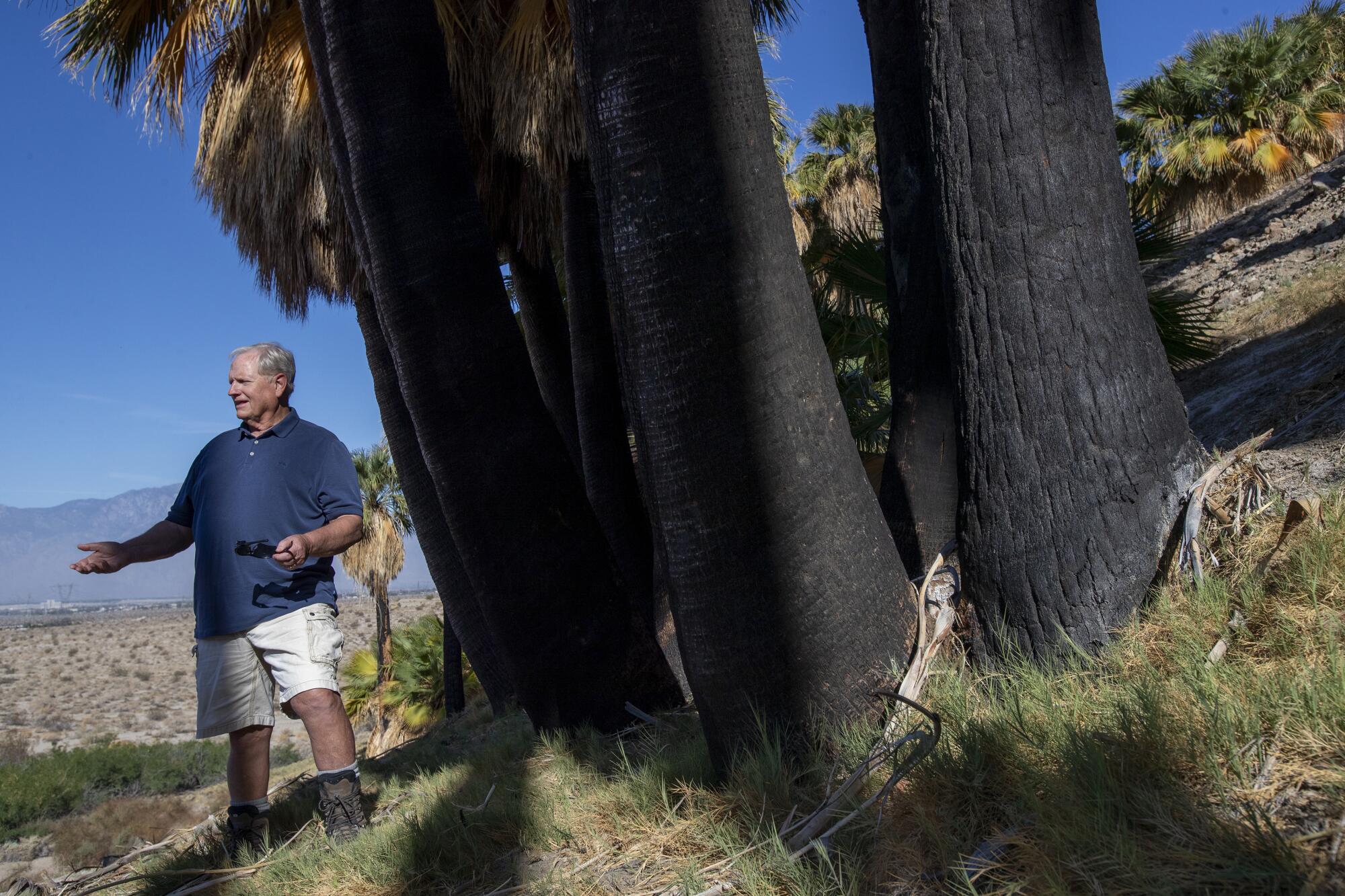
A gray-and-white-feathered northern mockingbird perched on a tree branch near the patio and stared down at Cornett as if waiting to be acknowledged. Cornett said he and the bird have gotten to know each other.
But while some routines in this backyard menagerie endure, others have become less constant. Cornett said that several years ago, he hired someone to trim the tall grasses at the edge of his property. Over two days, the gardener found 19 rattlesnakes, which Cornett — who in 1999 published “Rattlesnakes!: Answers to Frequently Asked Questions” — personally captured and moved to the nearby ravine.
“I haven’t seen a rattlesnake in three years,” Cornett said.
He attributed their absence to a drier climate. When wildflowers were plentiful, they dropped seeds that were eaten by rodents, which were eaten by snakes. But ongoing drought has put pressure on that cycle.
Annual rainfall totals illustrate how the naturally harsh desert environment is becoming even more stressed. Cornett, who meticulously studies weather data compiled by the National Oceanic and Atmospheric Administration, said less than 1 inch of rain has fallen at the Palm Springs airport since Nov. 1, well below averages of roughly 4.5 inches for the period over the last half-century, which were down from a 5.5-inch average before that.
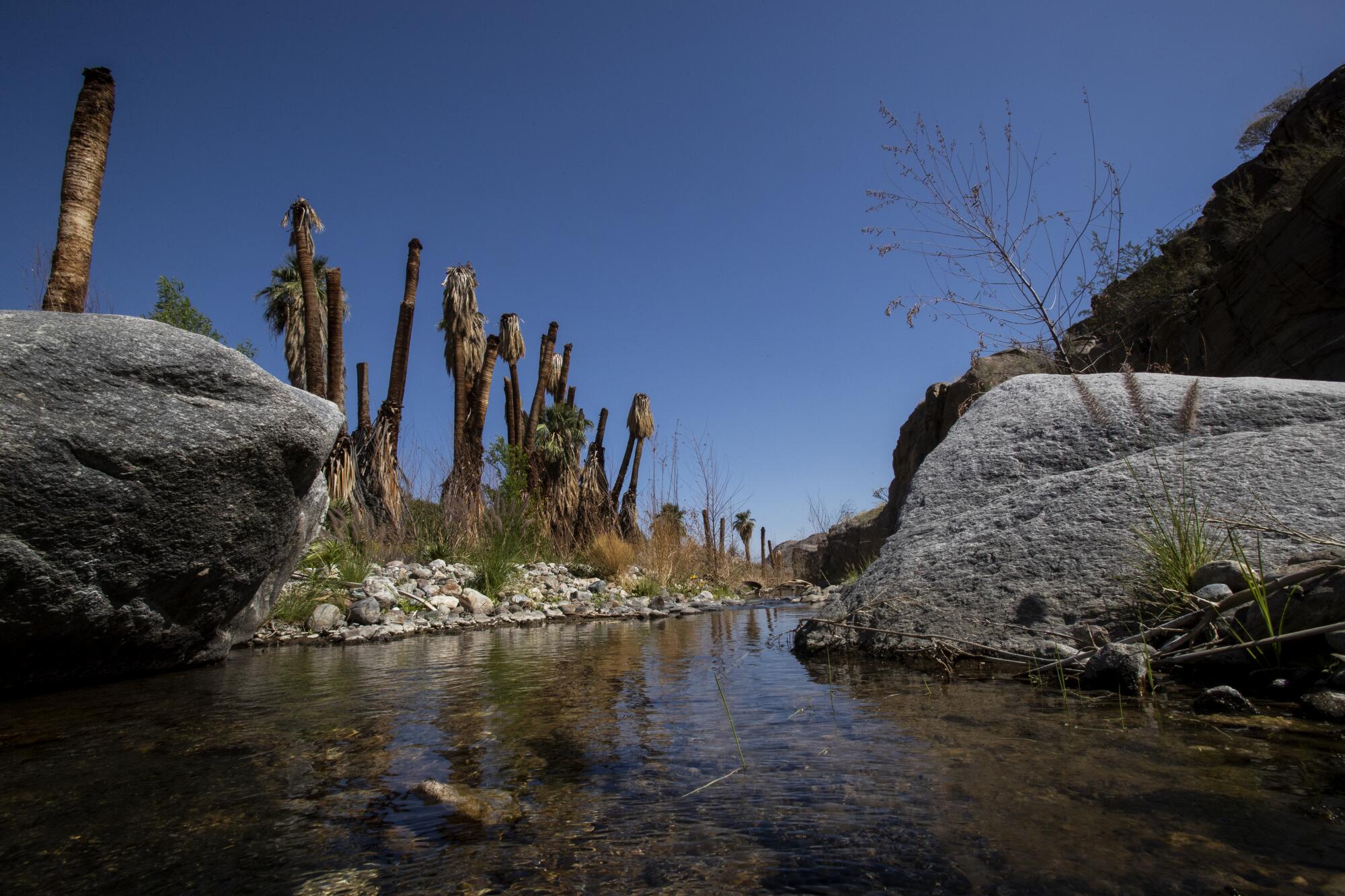
“We are getting about 20% less rain on average in the last two decades than we did prior to that,” said Cornett, who also noted that average desert temperatures have risen by just under 2 degrees since the middle of the last century.
That might sound like a modest change to some people, Cornett said.
But for fragile natural environments like those in California’s deserts, he said, the combination of hotter weather and less rainfall can be catastrophic. And something we all took for granted — the occasional glorious explosion of spring wildflowers — could become more rare.
“The desert will always have years of super bloom and years when there’s nothing,” Cornet said. “The difference now is that drought is becoming more common, and the intervals between super blooms will be greater.”
The drought in the western United States is putting California’s reservoirs at dangerously low levels.
In time, Cornett said, some plants and animals will adapt, but “we will see less of everything” as climate change puts new pressures on virtually all desert species.
For centuries, change was barely noticeable, Cornett said. Today, the transformation is accelerated, and we are “watching life on Earth struggle to adapt.”
::
Cornett is not the only researcher to document the alarming transformation of the desert. In 2005, climate scientist Kenneth Cole predicted that in some areas, Joshua trees — iconic symbols of Southwestern desert landscapes — would soon be in trouble because of climate change.
In a 2011 study, Cole and colleagues projected “the future elimination” of the Joshua tree “throughout most of the southern portion of its current range.” The retired Northern Arizona University professor told me recently that he went from being somewhat skeptical about the perils of climate change in the 1980s to seeing the decline with his own eyes.
“I’ve been despondent about the future of the globe since about 1990,” he said. “If we made an all-out effort, we could nip it in the bud, but I don’t see that happening…. It’s crushing. It is really crushing.”
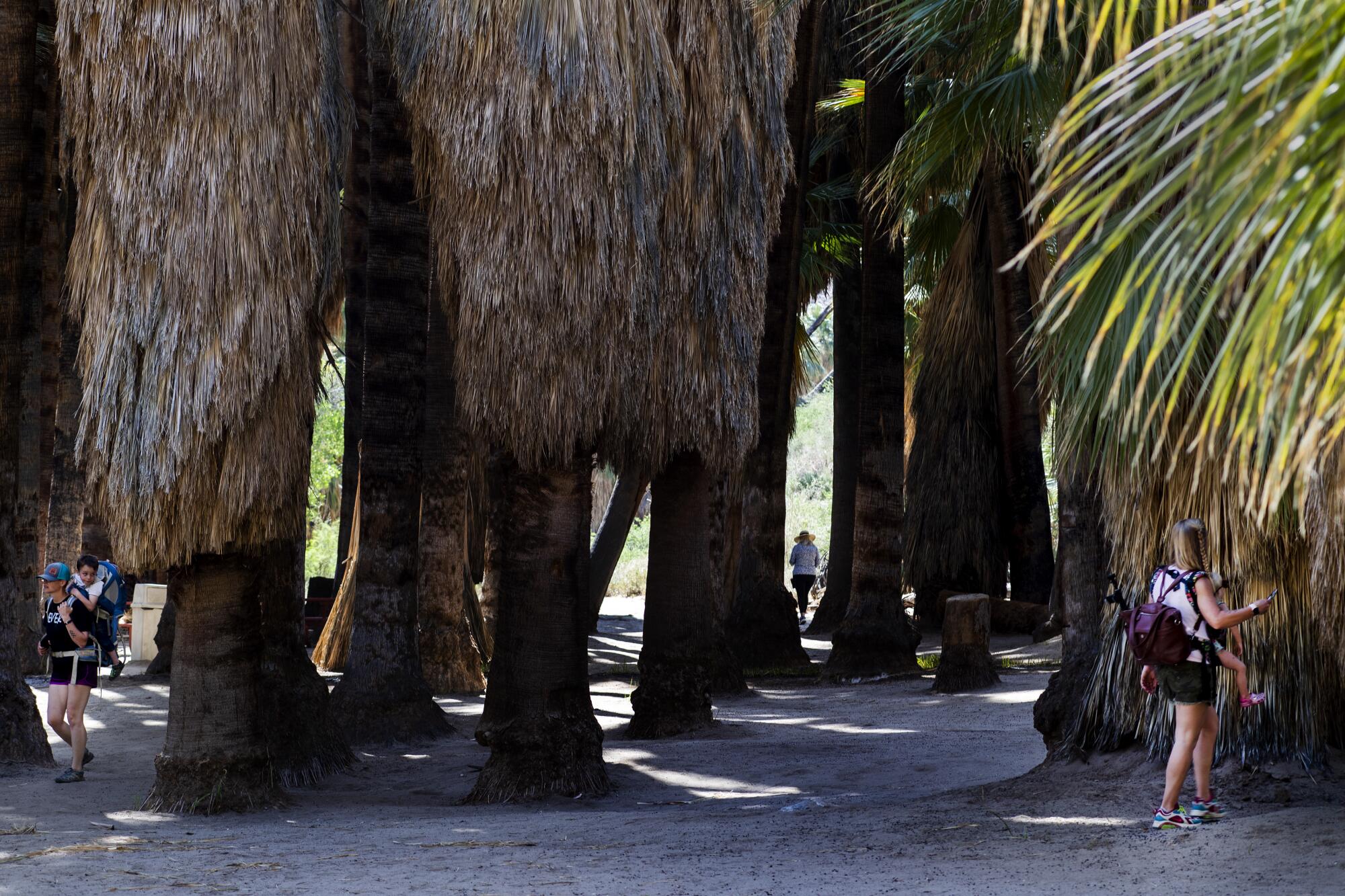
In 2011, professor Cameron Barrows, a researcher at UC Riverside’s Center for Conservation Biology, studied the decline of trees in Joshua Tree National Park and was part of a follow-up study eight years later. That team of researchers predicted “an almost complete elimination of the species from the park by the end of the century.”
The good news, Barrows told me, is that Joshua trees “are more resilient” at higher elevations of the national park. But at lower elevations, he said, there is little or no “recruitment,” a term used to describe the growth of new trees seeded by mature trees.
A healthy Joshua tree looks like a creation cooked up by Mother Nature after a few cocktails with Dr. Seuss. They can stand 40 feet or taller, punching the sky with goofy, gnarled fists. As many as 3 million people visit the national park annually to see them and the rest of the exotic plant life in the distinctive, rocky landscape.
A new study has calculated that more than one-third of global heat deaths can directly be attributed to human-caused climate change.
One of 10 Joshua tree study sites Cornett has been monitoring since 1988 lies in an area at the center of Joshua Tree National Park called Queen Valley. In 1988, he tagged 40 trees at this location. Today, there are only four living trees. A fire about 20 years ago, ignited by a lightning strike, led to the eventual death of the others.
And none of the four survivors look like they’re going to make it.
When we visited, dry limbs drooped. Some barrel-shaped, dead leaf clusters dangled while others had fallen to ground as dry as death. In decades past, those clusters dropped seeds that sprouted after rains.
“There’s no recruitment” now, Cornett said, scanning an area without a single sprout.
A drier climate means more vulnerability to fires caused by lightning or vandalism. There’s no more devastating example than last year’s Dome fire at the Mojave National Preserve, an hour or so to the north. The fire, ignited by lightning, incinerated more than 1 million Joshua trees.
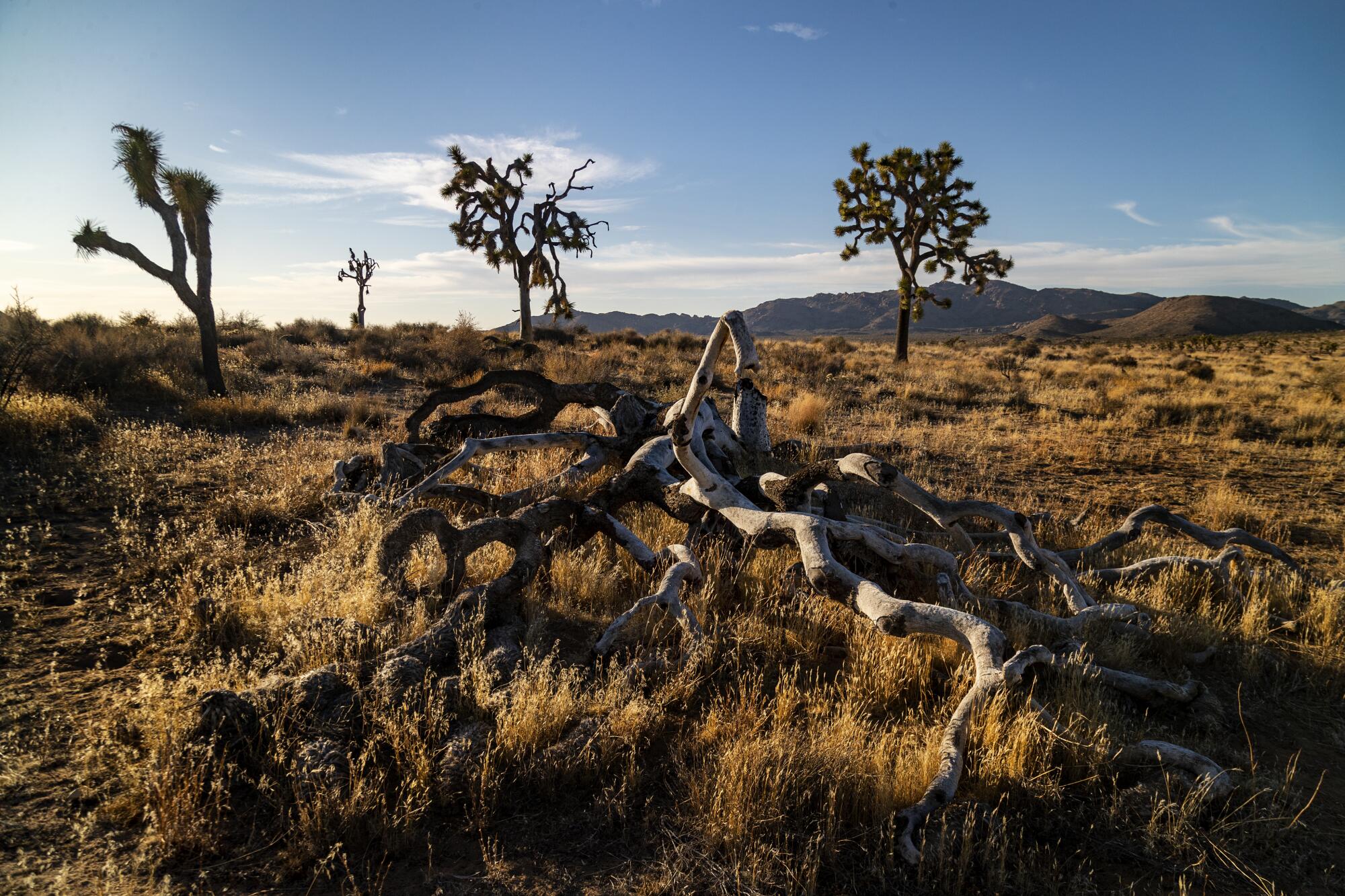
At the Queen Valley site, Cornett examined the stems of the four surviving trees and discovered yet another assault on their health.
“This is the first time I’ve seen signs of rodents attacking stems on this site,” he said, pointing out some gnawed branches.
As with the ocotillo, the problem seemed to be that the plants usually found around the trees were dead or dying, leaving virtually no moisture for rodents. They appeared to have dug their teeth into Joshua trees in a last-ditch effort to survive.
At the base of one tree, whose age Cornett put at about well over 100, he noticed another threat: A patch of bark had been scraped away.
Cornett crouched, inspected, harrumphed. It looked like the work of a jackrabbit, he said, which must have been trying to get at the moisture in the stem.
“To chew through bark like that,” he said, “that is one desperate jackrabbit.”
Cornett studies Joshua trees for a couple of reasons. They’re a keystone species, meaning they are crucial to a habitat that includes reptiles, insects, birds and other wildlife. And they are known and appreciated by the public, so evidence of their gradual demise might make us all more inclined to consider the planet’s fragile state and do something about it.
We can all play a role, Cornett said, by whom we vote into office. We can convert to greener energy sources, make the switch to electric vehicles and build smaller rather than larger homes, with conservation-minded design. It doesn’t help that in the sprawl of Palm Springs, air conditioners drone for months, and lush golf courses and farms pump water from dwindling sources and diminished aquifers.

As we toured the park, Cornett took note of visitors photographing ocotillo plants and Joshua trees that had seen better days. The thorny, hardy creosote bushes are doing fine, he said, but he couldn’t imagine people would book hotels, dine at local restaurants and get out their cameras for a tour of Creosote Bush National Park. As these changes shake up the natural world, the broader economy may feel some of the pain.
“I would argue right now that Joshua Tree National Park is not the best place to go to see Joshua trees,” Cornett said.
But he knows a place that might be, and he promised to take me there.
::
Jim Cornett moved around quite a bit as a child because his father, a city manager, took jobs in several cities, including Riverside. He and his siblings looked forward to the family’s birthday tradition, in which each of them would take a trip with Dad.
“So he said, ‘Jimmy, where do you want to go?’ I thought Death Valley sounded so exciting. At 6, I had discovered something called dinosaurs, and I thought the closest thing to seeing a dinosaur would be desert reptiles.” On his 10th-birthday trip to the desert, Cornett caught a side-blotched lizard and a tarantula and took them home, “and it kind of snowballed from there.”
A forecast says it’ll likely be so hot in the next five years that there’s a 40% chance the globe will push past the limit set by the Paris climate accord.
Cornett majored in political science at UCLA, then became a teacher in Twentynine Palms and later Palm Springs. In his 20s, he pitched a newspaper column on natural science that ran for 40 years in the Desert Sun. As a fledgling journalist, he figured he’d have more credibility with formal training in the sciences, so he went back to school for a biology degree at UC Riverside and later a master’s at Cal State San Bernardino.
Cornett, a man with a busy calendar, has also led nature walks at the Living Desert Zoo and Gardens and ran his own desert ecology consulting business, even while writing columns and books. But for 30 years, his primary occupation was to run the natural science division of the Palm Springs Desert Museum, a job that took him to the great deserts of the world to better appreciate and understand California’s Sonoran and Mojave deserts. And he often took grateful colleagues along with him.
“He shared his passionate love for nature with all of us in such a personal way that it changed our lives forever,” said Janice Lyle, who ran the Desert Museum while Cornett worked there. Lyle’s daughter became a park ranger in part because of Cornett’s inspiration.
His enthusiasm, unlike the desert habitats he studies, has not diminished.
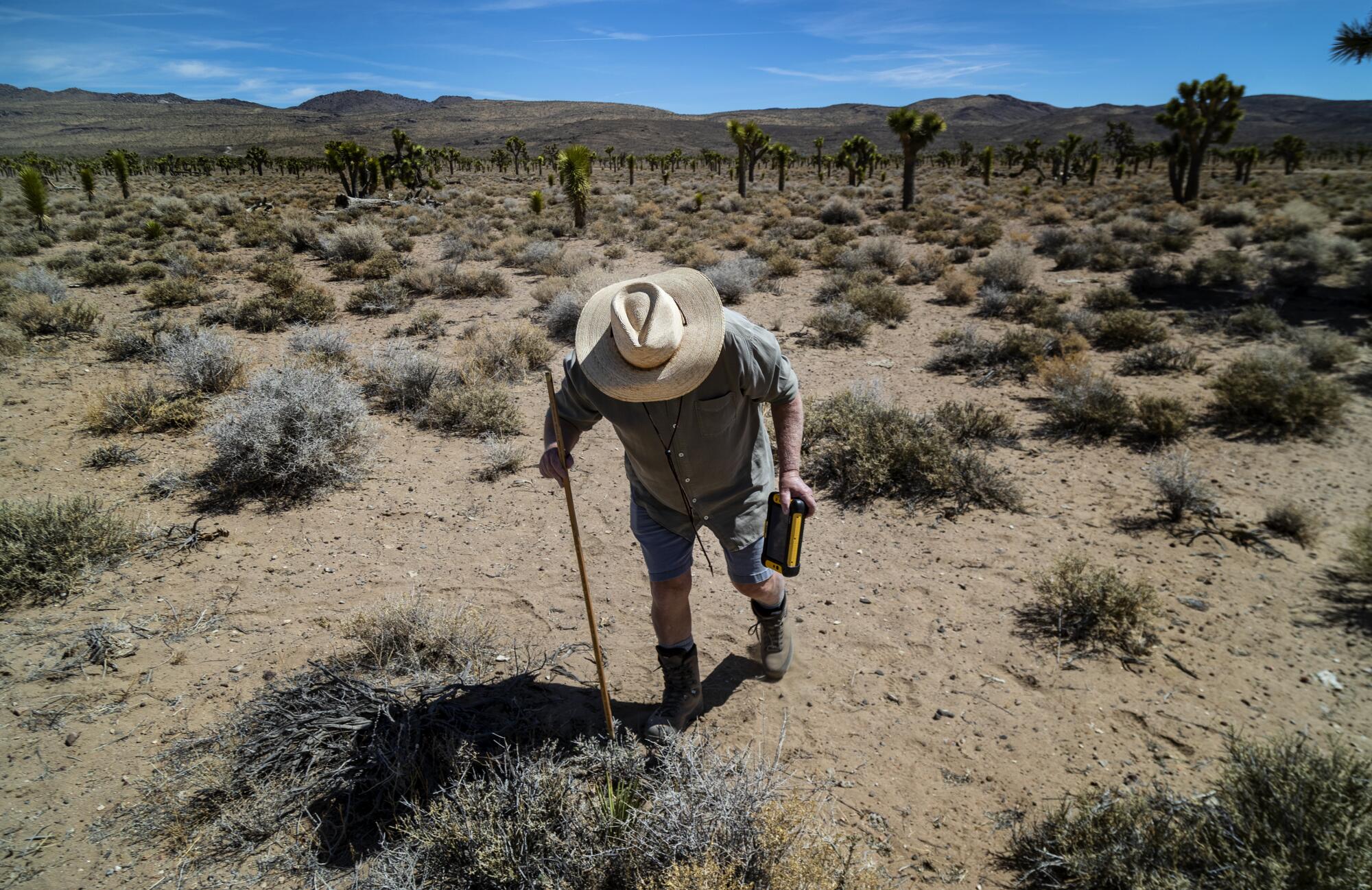
“I get as excited today as I was when I was 6,” said Cornett, who tours the great deserts in a white Jeep with a “FANPALM” license plate. Yes, a Jeep, because he needs a four-wheel-drive vehicle for his research, Cornett said. But he wanted me to know that he insisted on the six-cylinder engine, rather than the eight-cylinder gas burner the salesman pitched him.
At Indian Canyons on the Agua Caliente reservation near Palm Springs, Cornett pointed out a bush and said, “Now this is a mesquite.” The author of “Indian Uses of Desert Plants” told me the bean pods were a valuable source of protein for Cahuilla Indians.
In the desert, fan palm oases are often found along earthquake faults, where crushed sediment pushes groundwater toward the surface. The palms at the center of the Indian Canyon oasis were healthy, but Cornett pointed out several others a couple of hundred yards down Andreas Creek that were as dry as scarecrows.
For my last outing with Cornett, we met up in Lone Pine and then traveled east into Death Valley to Lee Flat, which sits at an elevation of 5,300 feet. Ahead of us, flocks of horned larks darted about, just above the ground, and Cornett said they were hunting for seeds from the wildflower blooms in years past.
For now, human traffic is relatively light at Lee Flat, which has its benefits. As Cornett put it, vehicle and foot traffic have had their own negative impact on desert life. But it’s cooler at Lee Flat than in much of the desert, and though there’s minimal rainfall, the water is less apt to evaporate.
The result is a spectacular forest of Joshua trees.
Cornett trudged through the field in his dusty shin-high boots, revisiting marked trees he’s been monitoring for three decades.
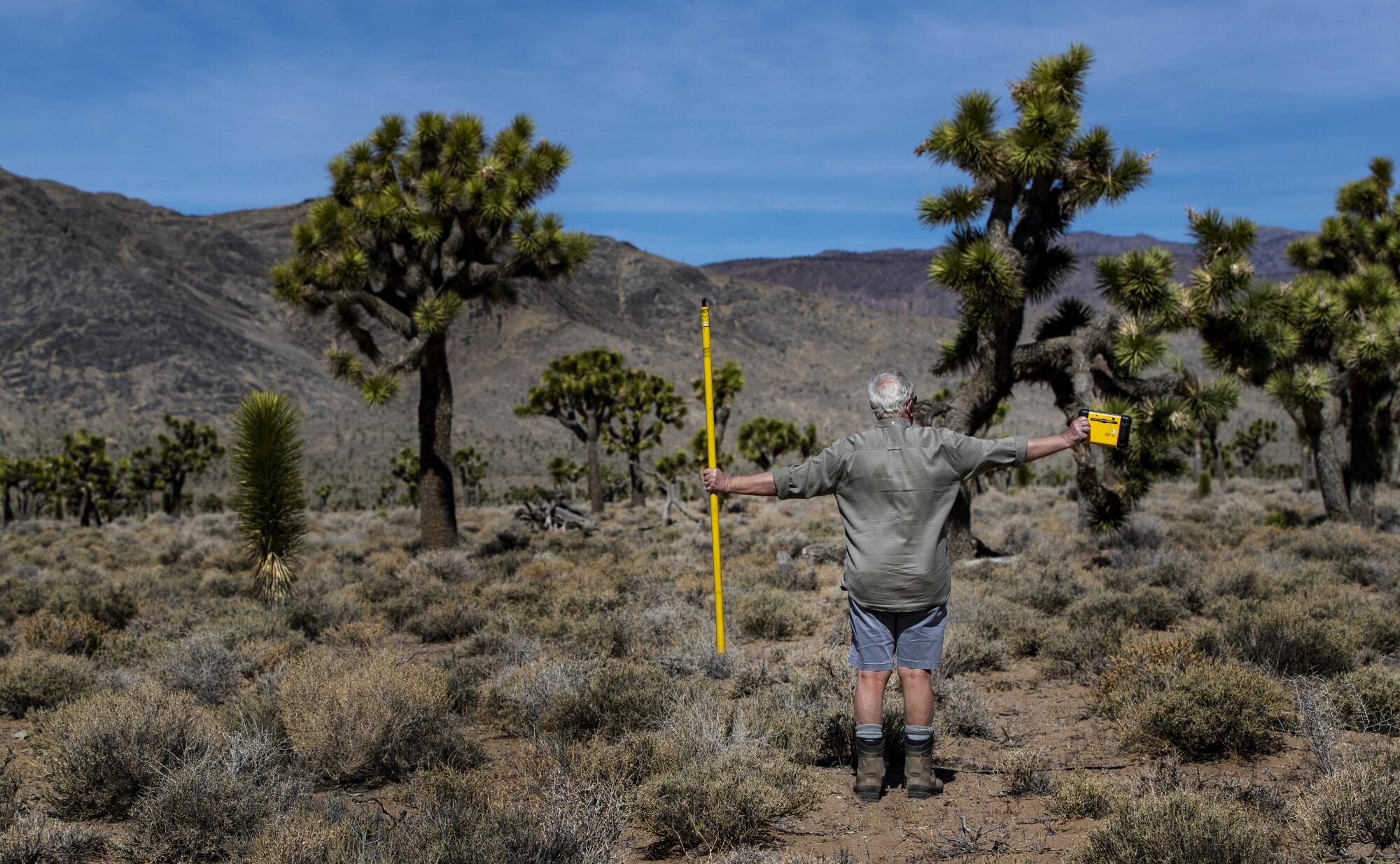
“They’re all healthy,” he pronounced with his easy smile, and all around the mature trees, youngsters were sprouting by the dozens.
This is already perhaps the best place in California to see Joshua trees, Cornett said, and that’s worth celebrating. But it’s also important to recognize why that’s true. Joshua trees are still able to thrive at higher elevations because the changing climate hasn’t caused as much disruption to the ecosystem there. Yet.
But climate change models make it clear that natural rhythms might one day be affected here too.
“I was hoping that when I left the planet as a living and breathing human being, I would have left it in a better state than it was in when I was born,” Cornett said. “I can now say with certainty that upon my death, the Earth will be in more trouble than it was in when I was born.”
At Lee Flat, under a thin veil of silky white clouds, Cornett pulled out a telescopic tool and gave it a twist, shooting a measuring stick up through some limbs and all the way to the top of a Joshua tree.
“Thirty feet tall,” he said, relieved that by all available evidence, in this one corner of a changing planet, for now, the trees are OK.
More to Read
Sign up for Essential California
The most important California stories and recommendations in your inbox every morning.
You may occasionally receive promotional content from the Los Angeles Times.

